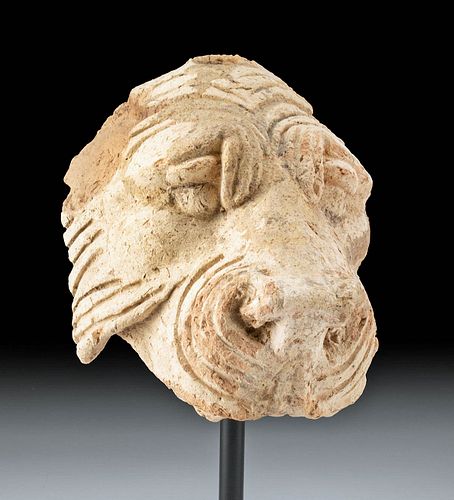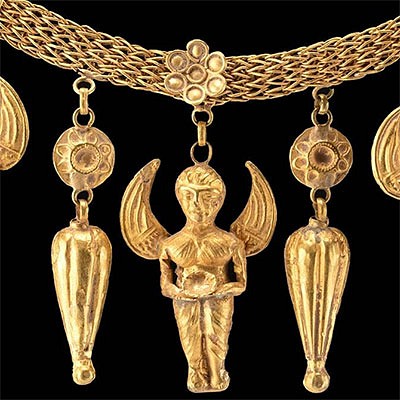Eastern Roman Terracotta Head of a Lion
Lot 25
About Seller
Artemis Gallery
686 S Taylor Ave, Ste 106
Louisville, CO 80027
United States
Selling antiquities, ancient and ethnographic art online since 1993, Artemis Gallery specializes in Classical Antiquities (Egyptian, Greek, Roman, Near Eastern), Asian, Pre-Columbian, African / Tribal / Oceanographic art. Our extensive inventory includes pottery, stone, metal, wood, glass and textil...Read more
Categories
Estimate:
$1,500 - $2,000
Absentee vs Live bid
Two ways to bid:
- Leave a max absentee bid and the platform will bid on your behalf up to your maximum bid during the live auction.
- Bid live during the auction and your bids will be submitted real-time to the auctioneer.
Bid Increments
| Price | Bid Increment |
|---|---|
| $0 | $25 |
| $300 | $50 |
| $1,000 | $100 |
| $2,000 | $250 |
| $5,000 | $500 |
| $10,000 | $1,000 |
| $20,000 | $2,500 |
| $50,000 | $5,000 |
| $100,000 | $10,000 |
| $200,000 | $20,000 |
About Auction
By Artemis Gallery
Dec 3, 2020
Set Reminder
2020-12-03 10:00:00
2020-12-03 10:00:00
America/New_York
Bidsquare
Bidsquare : Fine Antiquities, Ethnographic & Fine Art
https://www.bidsquare.com/auctions/artemis-gallery/fine-antiquities-ethnographic-fine-art-6119
Features classical antiquities, ancient and ethnographic art from cultures encompassing the globe. Egyptian, Greek, Roman, Etruscan, Near Eastern, Asian, Pre-Columbian, Native American, African / Tribal, Oceanic, Spanish Colonial, Russian, Fine Art, so much more! All legally acquired, legal to sell. Artemis Gallery info@artemisgallery.com
Features classical antiquities, ancient and ethnographic art from cultures encompassing the globe. Egyptian, Greek, Roman, Etruscan, Near Eastern, Asian, Pre-Columbian, Native American, African / Tribal, Oceanic, Spanish Colonial, Russian, Fine Art, so much more! All legally acquired, legal to sell. Artemis Gallery info@artemisgallery.com
- Lot Description
Roman, Holy Land, Eastern Empire, Imperial Period, ca. 1st to 3rd century CE. A finely preserved fragment of a hand-built terracotta lion head perhaps meant as a cult statue or part of an architectural element. The fine feline presents a prominent snout with flared nostrils surrounded by incised whiskers, sensitive eyes framed within peaked brows, layered wrinkles across the brow, and billowing tufts of fur draped from the cheeks. The exterior surfaces are covered with faint beige pigment that was perhaps further adorned with vibrant pigment when first sculpted. Size: 5.5" L x 3.75" W x 3.8" H (14 cm x 9.5 cm x 9.7 cm); 6.9" H (17.5 cm) on included custom stand.
Provenance: private New York, New York, USA collection; ex-private Daryl Gruber Kulok collection; Daryl Gruber Kulok (1960-2019) had homes in New York city and Connecticut and was fascinated with archaeology of the holy land. In America, she was on the philanthropic board of the Lila Gruber Research Foundation. Later in her life, she spent a good deal of time in Jerusalem where she was on the board of the American Friends of the Bible Lands, and was a serious collector of ancient art and artifacts. She was a student of biblical archaeology, and dedicated to supporting causes related to Israel. She was a major benefactor the Bible Lands Museum in Jerusalem, an institution "where people of all faiths are welcome to learn and understand our shared history." She was the key contributor to "Three Faces of Monotheism," a major exhibition there in 2007 which explored shared themes between Judaism, Christianity and Islam. Many of the pieces she donated are part of the Bible Lands Museum permanent collection.
All items legal to buy/sell under U.S. Statute covering cultural patrimony Code 2600, CHAPTER 14, and are guaranteed to be as described or your money back.
A Certificate of Authenticity will accompany all winning bids.
We ship worldwide and handle all shipping in-house for your convenience.
#159257This is a fragment of a larger composition as shown. Chips and abrasions to facial features and peripheries, with light encrustations within some recessed areas, and minor fading to areas of pigmentation. Nice earthen deposits and great preservation to eye and snout details.Condition
- Shipping Info
-
All shipping is handled in-house for your convenience. Your invoice from Artemis Gallery will include shipping calculation instructions. If in doubt, please inquire BEFORE bidding for estimated shipping costs for individual items.
-
- Buyer's Premium



 EUR
EUR CAD
CAD AUD
AUD GBP
GBP MXN
MXN HKD
HKD CNY
CNY MYR
MYR SEK
SEK SGD
SGD CHF
CHF THB
THB














